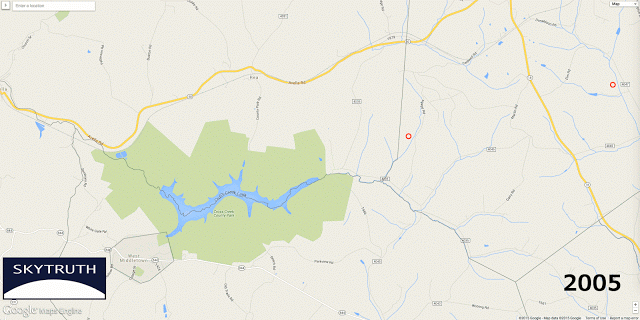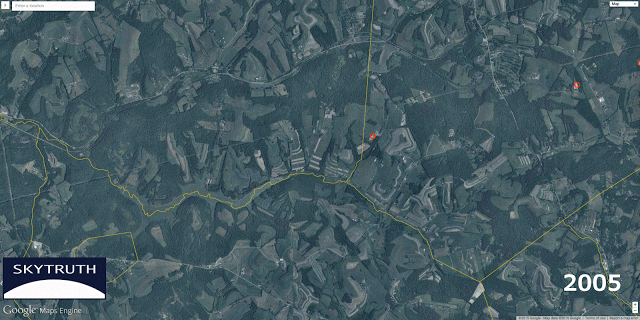| Online: | |
| Visits: | |
| Stories: |

| Story Views | |
| Now: | |
| Last Hour: | |
| Last 24 Hours: | |
| Total: | |
Inside a Hotspot: A Timelapse of Shale Drilling in Pennsylvania
Earlier this month we published a map of active Marcellus shale wellpads in Pennsylvania as observed on aerial survey imagery from 2005, 2008, 2010, and 2013 by our FrackFinder citizen scientists. Now we thought we’d take a closer look at one of those hotspots of drilling activity, specifically an area in Washington County, PA near Cross Creek County Park and the town of Hickory.
For this visualization, we created a 3.4 acre buffer around each active wellpad, a number we derived from our related work mapping the footprint of wellpads in Eastern Ohio. We have not yet measured the cumulative footprint of drilling activity in Pennsylvania, so we used the median area for wellpads in Ohio’s Marcellus and Utica shale play.
However, the impact of drilling is not just restricted to the gravel parking lot around a wellhead, it extends to service roads, pipelines, waste impoundments, gas separators, compressor stations, etc. So to visualize that impact, we have also included a snapshot of the aerial survey imagery for the same area from each of the respective years.
These visuals are cumulative, meaning that not every wellpad was visibly active at the time of the aerial survey. However, given the predicted lifespan of shale wells we can expect that almost all of these sites could be expanded and re-fracked several times over the coming decades. If you want to take a closer look you can download high-resolution stills from our album over at Flickr or explore the interactive map of all observed, active wellpads in Pennsylvania.
This kind of dense drilling activity in close proximity to homes and towns is cause for serious concern with recent findings by our partners at Johns Hopkins who found that “expectant mothers living in the most active area of fracking drilling and production activity were 40 percent more likely to give birth prematurely (before 37 weeks of gestation).” Our goal with these maps and mapping projects is that the resulting data will be used to better understand the public health and environmental impacts of resource extraction activities like fracking.
Source: http://blog.skytruth.org/2015/10/inside-hotspot-timelapse-pa-shale.html





